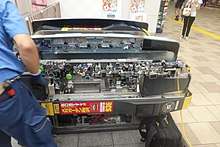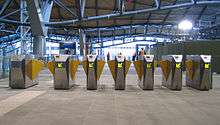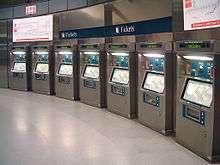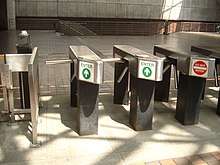Automated fare collection
An automated fare collection (AFC) system is the collection of components that automate the ticketing system of a public transportation network - an automated version of manual fare collection. An AFC system is usually the basis for integrated ticketing.


System description
AFC systems often consist of the following components (the "tier" terminology is common, but not universal):
- Tier 0 - Fare media
- Tier 1 - Devices to read/write media
- Tier 2 - Depot/station computers
- Tier 3 - Back office systems
- Tier 4 - Central clearing house
In addition to processing electronic fare media, many AFC systems have equipment on vehicles and stations that accepts cash payment in some form.
Fare media
AFC systems originated with tokens or paper tickets dispensed by staff or from self-service vending machines. These have generally been replaced with magnetic stripe cards.
Since their introduction in 1997 with the Octopus card in Hong Kong, contactless smart cards have become the standard fare media in AFC systems, though many systems support multiple media types.
More recently, contactless smart cards from bank networks have been seen more frequently in AFC.
Devices to read/write media
These take numerous forms, including:
- Ticket office terminals - where a media holder can purchase a right to travel from staff in an office, or enquire as to the value and travel rights associated with the media

- Ticket vending machines - where a media holder can purchase a right to travel from a self-service machine, or enquire as to the value and travel rights associated with the media
- Fare gate - often used in a train station so a media holder can gain access to a paid area where travel services are provided
- Stand-alone validator - used to confirm that the media holds an appropriate travel right, and to write the usage of the media onto the media for later verification (e.g. by a conductor/inspector). Often used in proof-of-payment systems.
- On-vehicle validator - used by a media holder to confirm travel rights and board a vehicle (e.g. bus, tram, train)
- Inspector/conductor device - used by staff such as a conductor to verify travel rights
Unattended devices are often called "validators", a term which originated with devices that would stamp a date/time onto paper tickets to provide proof of valid payment for a conductor.
Depot/station computers
Used to concentrate data communications with devices in a station or bus depot. Common in older AFC systems where communication lines to upper tiers were slow or unreliable.
Back office
Servers and software to provide management and oversight of the AFC system. Usually includes:
- Fare management - changing of fares and fare products
- Media management - support for blacklisting of lost/stolen media
- Reporting - periodic reports on performance of the AFC system, financial details and passenger movements
Clearing house (Central Management System)
In environments where multiple system operators share common, interoperable media, a central system similar to those used in stock exchanges can be used to provide financial management and other services to the operators such as:
- Clearing and settling of funds
- Common reporting
- Apportionment of revenue between operators
Automated fare collection in Canada

Canada's first public transit agency, the Toronto Street Railway Co., started in 1861 with a horse-drawn streetcar service but it was not until 1912 that the City of Toronto began deliberations on fare collection.[1] It was not until 126 years later (in 1987) that Mississauga Transit became one of the first Transit Agencies in Canada to implement an Electronic Farebox.[2] Since then, almost every major city in Canada has adopted use of electronic fare boxes.
Notably, Canada also produces fare collection devices for various transit agencies in North America. Trapeze Group., located in Mississauga, Ontario, currently manufactures and develops high tech fare collection solutions.
Automated fare collection in the United States

The first faregates in United States were installed experimentally in 1964 at Forest Hills and Kew Gardens Long Island Rail Road stations in Queens;[3] the first systemwide installation was on Illinois Central Railroad (IC) in 1965 for its busy Chicago commuter service (today's Metra Electric.) Financed entirely from private funds, AFC was expected to reduce operating costs by decreasing on-board crew sizes and eliminating station agents at all but the busiest stations. Cubic’s IC system featured entry-exit swipes (NX) to enforce zonal fare structures, checks against fraud, used ticket collection, and ridership/revenue data collection capabilities.[4] It served as a prototype for the San Francisco Bay Area Rapid Transit (BART),[5] Washington Metropolitan Area Transit Authority (WMATA),[6] and Philadelphia’s Port Authority Transit Corporation (PATCO) Lindenwold Line NX-zonal AFC systems.[7] These railroad-style systems required complex computer data processing on faregates or remotely on a central computer, and thus were not suitable for buses. Similar systems are still in use on Japan and Taiwan’s commuter railroads, and the London Underground.[8]
Metropolitan Atlanta Rapid Transit Authority (MARTA)’s desire for simpler AFC systems resulted in Duncan (traditionally a parking meter vendor) developing turnstile machines for entry-only subway fare collection. Chicago Transit Authority (CTA)’s ChicagoCard, Boston Massachusetts Bay Transportation Authority (MBTA)’s previous generation “T-Pass”, and New York City Transit (NYCT)’s MetroCard systems could all be considered MARTA’s 1977 system’s conceptual descendants.
Bus fareboxes had hitherto been much simpler devices, mechanically registering coins deposited on accumulating registration counters. Duncan’s 1973 “Faretronic” farebox was the first to electronically count coins and collect revenue/ridership data by fare class. Keene quickly followed suit, introducing a design meeting Urban Mass Transit Administration (UMTA) Section 15 reporting requirements, also collecting fuel consumption and bus mileage data.[9] In New York, mechanical fareboxes were preferred for ease of maintenance until widespread deployment of Cubic's MetroCard for buses in 1997. Venerable GFI fareboxes featuring magnetic pass readers requiring cash single fares lasted in Boston until Scheidt-Bachmann’s CharlieCard was introduced in 2006.
Examples
This is a list of a few notable AFC systems. (See List of smart cards for a comprehensive list of AFC and other systems based on contactless smart cards.)
| Location | Brand | Notes |
|---|---|---|
| Netherlands | OV-Chipkaart | This is the Dutch national AFC system. It works on all types of public transport in the whole country including Bus, Tram, Metro and Train (both regional and intercity). The system is sponsored by the Dutch government and run by Translink Systems in cooperation with individual transportation companies. |
| Incheon | Cashbee card | Provides a various AFC solutions and consulting services(EB Card - LDCC) |
| Busan | Cashbee card | Provides a various AFC solutions and consulting services(Mybi - LDCC) |
| Tehran | E-Ticket | Contactless smart cards for transportation(Subway and Bus)+Parking meter+CharityBox |
| İzmir | İzmirimkart[10] | Contactless smart cards for transportation |
| İstanbul | akbil/istanbulkart[11] | Contactless smart cards for transportation, supports 14 different operators since 1995. |
| Seoul | T-money | Provides a various AFC solutions and consulting services |
| Hong Kong | Octopus card | The first to use contactless smart cards in volume |
| Philippines | Beep card | Intermodal AFCS solutions and smart-city design |
| Ankara | AnkaraKart[12] | Contactless smart cards for public transport |
| India | More card | Contactless smart cards for public transport |
| Medellín | Cívica | Contactless smart cards for public transport |
| Melbourne | Myki | Contactless smart cards for public transport |
| Sydney | Opal card | Contactless smart cards for public transport |
| Metro Vancouver | Compass Card | Contactless smart cards for all modes of public transit in the Metro Vancouver Regional District |
| Moscow | Troika_card | Contactless smart cards for public transport |
| Singapore | EZ-Link | Supports the broadest number of modes, including tolls |
| Tbilisi | MetroMoney | Contactless smart cards for public transport |
| Southern Ontario | Presto card | Supports multiple cities in Southern Ontario, used by the majority of transit operators in the Greater Toronto, Hamilton & Ottawa Area |
| New York | MetroCard | A magnetic stripe system in the largest transit system in the USA |
| Chicago | Ventra | The largest automated fare collection contract ever placed in North America.[13] |
| Bangladesh | SPass[14] | Contactless smart cards in Bangladesh. |
| Malaysia | Touch 'n Go | Contactless smart cards Solutions provider. |
| Thailand | Rabbit Card | Rabbit contactless smart cards is an e-money system that can be used on the BTS and other mass transit networks.[15] |
| Niagara Falls | i-Ride Card[16] | i-Ride contactless smart card is a ride-based system that can be used in the Niagara Falls region of Ontario.[17] |
| Montreal | Opus Card | Contactless smart cards for public transport |
| Winnipeg | Peggo Card[18] | Contactless smart cards with online purchase and automated reload capabilities |
| Narva | Ridango | Automated Fare Collection System |
| Imatra | Ridango | Automated Fare Collection System |
| Södermanland | Ridango | Automated Fare Collection System |
| Västmanland | Ridango | Automated Fare Collection System |
| Gotland | Ridango | Automated Fare Collection System |
| Nuuk | Ridango | Automated Fare Collection System |
| Haapsalu | Ridango | Automated Fare Collection System |
| Viljandi | Ridango | Automated Fare Collection System |
| Pärnu | Ridango | Automated Fare Collection System |
| Klaipeda | Ridango | Automated Fare Collection System |
| Tartu | Ridango | Automated Fare Collection System |
| Kiev | Ridango | Automated Fare Collection System |
| Tallinn | Ridango | Automated Fare Collection System |
| Baku | Kentkart | Contactless smart cards for public transport |
| Doha | Kentkart | Contactless smart cards for public transport |
| Lahore | Kentkart | Contactless smart cards for public transport |
| Islamabad | Kentkart | Contactless smart cards for public transport |
| Tczew | Kentkart | Contactless smart cards for public transport |
| Amman | Kentkart | Contactless smart cards for public transport |
| Adana | Kentkart | Contactless smart cards for public transport |
| Alanya | Kentkart | Contactless smart cards for public transport |
| Antakya | Kentkart | Contactless smart cards for public transport |
| Antalya | Kentkart | Contactless smart cards for public transport |
| Aydın | Kentkart | Contactless smart cards for public transport |
| Bandırma | Kentkart | Contactless smart cards for public transport |
| Bodrum | Kentkart | Contactless smart cards for public transport |
| Burdur | Kentkart | Contactless smart cards for public transport |
| Çanakkale | Kentkart | Contactless smart cards for public transport |
| Edirne | Kentkart | Contactless smart cards for public transport |
| Fethiye | Kentkart | Contactless smart cards for public transport |
| İnegöl | Kentkart | Contactless smart cards for public transport |
| Isparta | Kentkart | Contactless smart cards for public transport |
| Kastamonu | Kentkart | Contactless smart cards for public transport |
| Kocaeli | Kentkart | Contactless smart cards for public transport |
| Lüleburgaz | Kentkart | Contactless smart cards for public transport |
| Mersin | Kentkart | Contactless smart cards for public transport |
| Muğla | Kentkart | Contactless smart cards for public transport |
| Niğde | Kentkart | Contactless smart cards for public transport |
| Sivas | Kentkart | Contactless smart cards for public transport |
| Yozgat | Kentkart | Contactless smart cards for public transport |
See also
References
- http://transittoronto.ca/spare/0021.shtml
- http://www.mississauga.ca/file/COM/Forum_Transit_General_Fact_Sheet_Web.pdf
- Fare Demonstration Project. In Headlights, Magazine of Electric Railroaders’ Association, Inc., New York, N.Y., August, 1964.
- Illinois Central Railroad. Illinois Central’s Gamble at Chicago: Private Breakthrough for a Public Cause. Chicago, Ill., circa 1968.
- Buneman, Kevin. Automated and Passenger-Based Transit Performance Measures. In Transportation Research Record 992, pp. 23-28, Transportation Research Board of the National Academies, 1984.
- Miller, Luther S. AFC: A Fare Deal for All – Mass Transit Automatic Fare Collection Systems. In Railway Age, Issue 5, Volume 195, May, 1994.
- Vigrass, J. William. The Lindenwold (New Jersey to Philadelphia) Hi-Speed Line: The First Twenty Years of the Port Authority Transit Corporation (PATCO). West Jersey Chapter, National Railway Historical Society, Cherry Hill, N.J., 1990.
- Ford, Roger. Technology Update: Ticket Issuing and Revenue Control. In Modern Railways, Volume 41, Pages 256-257, May, 1984.
- Young, David. The Business of Fare Collection. In Mass Transit Magazine, September, 1977.
- İzmirimkart, İzmirimkart. "İzmirimkart".
- akbil/istanbulkart, akbil/istanbulkart. "akbil/istanbulkart".
- AnkaraKart, AnkaraKart. "AnkaraKart".
- "Cubic Selected for Chicago Open Standards Fare System Contract". Cubic Transportation Systems. 17 Nov 2011. Archived from the original on 1 August 2013. Retrieved 2013-03-20.
- Spass, Spass. "Spass".
- "Archived copy". Archived from the original on 2014-07-29. Retrieved 2012-08-04.CS1 maint: archived copy as title (link)
- i-Ride Card, i-Ride Card. "i-Ride Card".
- http://www.niagarafalls.ca/living/transit/iride-pass-card.aspx
- Peggo Card, Peggo Card. "Peggo Card".